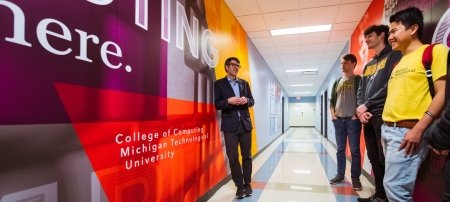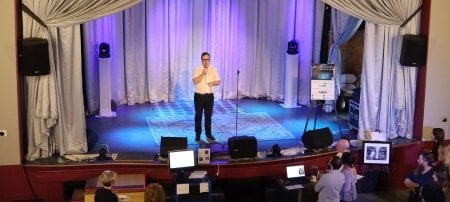In 2045, automation is king. Cars are not only self-driving, they’re getting ready to take flight. The US population is nearing 400 million, and the next evolution in urban renewal is underway. Technological advances are a daily occurrence, and robotization has changed the face of production and the workforce.
Meet Camila Romero and Isaac Matthews. They are among the students preparing to graduate as part of Michigan Tech’s class of 2045. Michigan Tech is 160 years old; the Portage Lake Lift Bridge is 86. Camila and Isaac were born in 2023, just six years from now. (Their parents may even be members of Michigan Tech’s 2017-18 entering class.) These students have had an educational experience very different from that of today’s students. But they are uniquely prepared to tackle the issues facing their generation.
Portrait of 2045: The portion of Michigan Tech’s Strategic Plan that contemplates the University’s existence several decades into the future. Some of these characteristics are captured in figures—target numbers for enrollment, for diversity, for endowment. Other characteristics are harder to quantify: globally literate graduates with strong communication skills; a transformational undergraduate experience in a residential learning environment; a university culture that is entrepreneurial, efficient, service-oriented, and sustainable.
But a portrait is not supposed to be a detailed description; it’s a likeness—open to individual interpretation and context. Here, we capture various versions of the Portrait of 2045, through the eyes of some of the University’s thought leaders, and in the creation of two fictional members of the class of 2045.
"We need to make sure we’re positioned to give students the skills they need to solve problems. Part of that comes from training in an academic discipline. In addition, there are a lot of things students need that aren’t taught in courses. Things like interpersonal skills, social engagement and habits of mind: problem solving, creativity, innovation, critical thinking, entrepreneurship."
The sun shines brightly on a May morning in 2045. Overhead, camera drones zip back and forth, jockeying for position above the line of graduating seniors. Camila Romero looks around at her peers, excited for the future, but a little apprehensive, too. In front of her, another student chats with his mother’s image on his hologram watch.
“Camila!” someone shouts. She turns toward the voice and sees her best friend, Isaac Matthews, jogging over, his mortarboard askew.
“You should fix your hat, Isaac,” she says with a smile.
Isaac shrugs his shoulders, and Camila knows what he’s about to say next.
Camila and Isaac met freshman year in their Global Issues class. The two were paired together in a month-long exercise to formulate and address a sustainable development problem. The project was part of a collaboration between Michigan Tech and a university in India, where first-year students were enrolled in a similar class. Along with their counterparts overseas, Camila and Isaac did a comparative study of the efficiency of microgrids in a rural section of the Upper Peninsula with a rural village in India.
The project would influence their next four years at Michigan Tech.
"You hear a lot of people saying we won’t need classrooms (in the future educational setting). But research shows learning is a very social activity. We learn from bouncing ideas off each other and arguing with each other. We learn from other points of view. There still needs to be someone who facilitates that learning and pushes people to think outside the box, who pushes people to see issues from multiple perspectives. Teachers and professors aren’t going away, but their role may be different."
Their Global Issues professor gave them A’s for what she called preliminary work. “If you want to continue with this project,” she said, “we can meet with the Academic Innovation department to modify your curriculum.”
After a couple hours of in-depth discussion on the back deck of the Downtowner, looking out on the Keweenaw Waterway, Camila decided to stick with her original plan to major in biomedical engineering. As much as she enjoyed her microgrid experience, her true passion lay elsewhere. Plus, a conversation with one of her team members in India had sparked an idea for a technology that would help heal wounds faster.
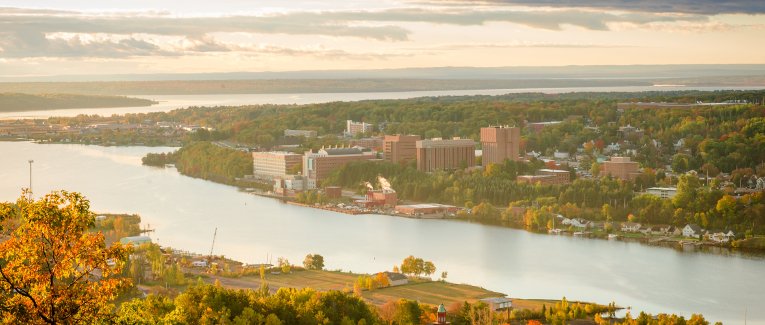
Isaac, on the other hand, had started his first year of college with far less career certainty than Camila. Hoping to find a profession that would be spared from death-by-automation, he’d been on the “general” track in Michigan Tech’s sustainability program. Now that he’d discovered how sustainable energy systems could help underserved communities, his path was coming into sharp focus.
"There are many paths to the same route. [Students] understand learning as a social process. It’s absolutely ridiculous that we would put barriers in their way in terms of access to information or people who can help them learn. We impose artificial deadlines on students and they smell that. The system has to be more honest and flexible about that."
The world Camila and Isaac have inherited is vastly different from the one we know today. Every technology they work with, improve upon, or develop as first-year students will be out of date by the time they reach their fourth or fifth year.
In his introduction to The Fourth Industrial Revolution, Klaus Schwab, founder of the World Economic Forum, describes the pace of profound shifts in the ways humans live. Around 10,000 years ago, he notes, the first shift occurred when people transitioned from foraging to farming. Food production slowly improved, leading to larger human settlements, urbanization, and cities.
But thousands of years passed before the next major shift would occur. It was not until the second half of the 18th century that mechanical inventions gave birth to a series of industrial revolutions. Each innovation—railroads and the steam engine; electricity and the assembly line; computers, personal computers, and the internet—demanded more highly skilled workers than the last.
We are now, according to Schwab, at the dawn of a fourth industrial revolution (hence the title of his book). This revolution is characterized not only by smart, connected machines and systems, but also by a wide-ranging scope of breakthroughs. “It is the fusion of these technologies,” he argues, “and their interaction across the physical, digital and biological domains that make the fourth industrial revolution fundamentally different from previous revolutions.”
While thousands of years passed between the first revolution and the second, and hundreds of years between the second and third, the third and fourth revolutions were separated by mere decades. Today, technologies are upgraded, or rendered obsolete, on a basis that is both rapid and gaining speed.
"A new approach we’re exploring with the undergraduate curriculum gives students a more hands-on experience. The traditional engineering education is based on lectures, but research suggests that students learn better when they can get involved in practice activities centered on the learning material. Instead of having labs, we have developed practice sessions. Also, the projects are open-ended. That is, there is no definite right or wrong way to solve the problems we give them. They learn to use engineering tools to come up with a solution that meets the given requirements. We’re asking them to interact with teammates, be creative, and to use critical thinking to realize their design. The employers like it. They believe the engineers they hire out of Michigan Tech are prepared to hit the ground running and think for themselves."
As part of her curriculum design, Camila joined a first-year Enterprise team who lived together in one of the sustainable tiny house communities scattered about campus. While she worked on a biosensor project to help her peers achieve more and better sleep despite the pressures of college, her team members developed an ultra-light material in which sleep sensors were embedded for their peers to curl up in at night. They called the special hammocks Catnap Cocoons.
Throughout her second and third years, Camila worked on several research projects, diversifying her skill set and knowledge base for a market that had seen nothing but rapid change for the past two decades. She had been primary research assistant to the professor who developed biosensors that could be inserted painlessly under the skin to monitor various health conditions. She had worked with her peers and research professors to improve SecondSkin, the wound-healing prosthetic epidermis developed to dramatically reduce healing time for diabetics.
With her experience in both research and augmented intelligence, Camila entered Career Fair with high hopes.
"We need to understand fundamental biological pathways. Can we understand enough of [the fundamentals] to solve problems? We’re at the baby steps. I think and I hope our curriculum will shift from rote memorization to hands-on problem solving. We may (create) a custom curriculum (for each student). Rather than looking at skills and knowledge linearly, students will specialize instead. As technology outpaces the way we teach, our teaching is going to have to catch up. There are already a huge number of students in this department that are heavily involved in undergraduate research. I have had about 65 undergrads work in my lab, so they can learn this is how science is really done. What we all need to keep in mind is that we’re doing the best we can with our skills and knowledge now. It’s a learning process. We need to be receptive to new information and ideas."
“The machines are coming for the high-wage, high-skill jobs as well,” warns Silicon Valley entrepreneur Martin Ford in his book Rise of the Robots: Technology and the Threat of a Jobless Future. Indeed, for at least a decade, thought leaders have been grappling with the possibility of a world in which robots are doing many of the jobs humans perform today.
Can Michigan Tech graduate a class of 2045 that’s automation proof?
The answer is a qualified yes—if not automation proof, then definitely automation resistant.
In December 2016, the Executive Office of the President released a report entitled “Artificial Intelligence, Automation, and the Economy.” Noting that artificial intelligence (AI) will likely change our notion of production and work in a fundamental way, the White House Council of Economic Advisors (CEA) predicted that jobs requiring manual dexterity, creativity, social interactions and intelligence, and general knowledge would thrive. The CEA identified four employment categories that might experience direct AI-driven growth in the future: engagement, development, supervision, and response to paradigm shifts.
"Having trained and worked with engineers, the best are the ones that can pull from the analytical and creative. Research is the search for knowledge. It happens on two levels. One, to understand the fundamental physics that’s there—the chemical processes, the biological reactions, all of it. There’s also the interactions beyond it, how it’s applied. The application of engineering knowledge will be so critical in 2045—with the sheer magnitude of human influence on this planet, we will either willingly or unwillingly be subjected to the laws of nature. That will depend heavily on whether we truly embrace a sustainability mindset."
Like Camila, Isaac’s curriculum design included Enterprise. Student-connections officers in the Academic Innovation department introduced him to students from computer and electrical engineering, materials science and engineering, and natural resources management who were interested in improving microgrid technology and efficiency in poor, rural areas. They collaborated with students in India, whom Isaac had met through the connections he made his first year.
Mentored by Professor Abboud, the Advanced Microgrids Enterprise team spent a year in practice sessions before creating prototypes, the parts for many of which were printed on their personal 3-D printers. Their work addressed not only engineering and efficiency, but sustainability and policy issues. At the start of their junior year, Isaac and another team member participated in the Entrepreneur Incubator program in the School of Business and Economics, with the goal to launch a business by 2045.
"Sustainability is a key underpinning for leadership. I would hope sustainability is integrated into all disciplines in a much greater extent. We need to make better decisions about the technologies we develop. The solutions might look very different if we expand our view to include economic impacts, environmental impacts, and societal impacts. Why waste money on something that won’t benefit people in the end?"
Sustainability. In simple terms, it’s the ability to maintain something at a certain rate or level. According to the UN World Commission on Environment and Development, sustainable development is development that meets the needs of the present without compromising the ability of future generations to meet their own needs.” For sustainable development to be achieved, the Commission says, it will be critical to build on three pillars: economic growth, social inclusion, and environmental protection.
"When I first came here, I came from a large, well-known research university that prided itself on doing fundamental research. The types of problems we solved were often esoteric. We developed elegant solutions to those problems, but the likelihood those solutions would be implemented in our lifetimes was small. At Michigan Tech, what struck me when I first arrived was that the people here were creating solutions to real problems that could be implemented almost immediately."
On a May morning in 2045, Camila Romero and Isaac Matthews stand among the members of Michigan Tech’s graduating class. Camila smiles at her best friend and tells him to fix his slightly askew mortarboard, but he shrugs his shoulders and makes a joke instead.
“Eh. I run my own business now. I can do what I want.”
Camila laughs. For a moment, she allows herself to get lost in a memory of her first week on campus at Michigan Tech. She smiles nostalgically when she remembers meeting Isaac, who like her had chosen to attend Michigan Tech because of the University’s focus on integrated sustainability and socially aware research.
Now he was starting his own business with collaborators around the world, and she was headed for a research position at a national lab outside Washington, DC. Her work as a research assistant had paid off—she had been hired to research wearable gene therapy devices for infants with congenital heart defects.
Camila and Isaac came to Michigan Tech because they believe in the power of science, technology, engineering, the arts, and math to solve complex problems when applied in tandem. They believe in thoughtful introduction of technologies that support, rather than hinder, human productivity and job growth. They believe in scaling up technologies to aid people in the developing world. Sustainability is core to their experience, and conducting life-cycle analysis of technologies to determine the effects on the environment and society are integrated into the work they do.
From inside the arena comes the sound of the processional music, signaling to the waiting students that the time has come to receive their degrees. Isaac and Camila smile at each other, a little nervous, but mostly jubilant. Their futures—and our planet’s future—are waiting.
Artificial Intelligence, Automation, and the Economy
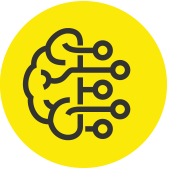
Engagement (or Augmented Intelligence)
Demands for labor will likely increase the most, the CEA predicted, in areas where humans “complement AI-automation technologies.” For instance, AI technology might improve detection of cancer or other diseases, but it can’t talk with patients about treatment options or guide them through treatment plans.
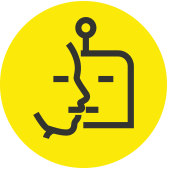
Development
“To a certain extent . . . AI is only as good as the data behind it,” the CEA said, “so there will likely be increased demand for jobs in generating, collecting, and managing relevant data to feed into AI training.” This shows the need for employees like Isaac, who have a background in social sciences or liberal arts. Social complexity and moral dilemmas require the knowledge of those who can, for example, conduct ethical evaluations.

Supervision
Everything related to monitoring, licensing, and repairing AI. Think autonomous vehicles. Humans will likely still need to register and test the cars to “ensure safety and quality controls on the road,” says the CEA.
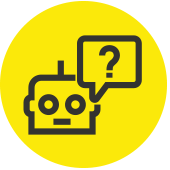
Response to Paradigm Shifts
The report describes how technological innovation surrounding AI could reshape features of our built environment. Think again of self-driving vehicles. Today’s traffic laws and infrastructure were designed with human drivers in mind. How will that change once computers are behind the wheel?
Michigan Technological University is an R1 public research university founded in 1885 in Houghton, and is home to nearly 7,500 students from more than 60 countries around the world. Consistently ranked among the best universities in the country for return on investment, Michigan's flagship technological university offers more than 185 undergraduate and graduate degree programs in science and technology, engineering, computing, forestry, business, health professions, humanities, mathematics, social sciences, and the arts. The rural campus is situated just miles from Lake Superior in Michigan's Upper Peninsula, offering year-round opportunities for outdoor adventure.

